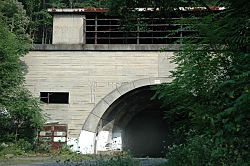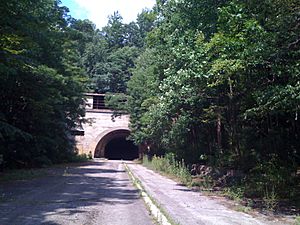Sideling Hill Tunnel facts for kids
 |
|
| West portal | |
| Overview | |
|---|---|
| Line | South Pennsylvania Railroad abandoned |
| Location | Blueridge Mountain Fulton County, Pennsylvania |
| Coordinates | 40°02′53″N 78°07′45″W / 40.048056°N 78.129167°W |
| Status | Abandoned Pennsylvania Turnpike Currently Pike2Bike Trail |
| Operation | |
| Work begun | 1881, railway 1938, highway |
| Closed | November 26, 1968, I-76 |
| Owner | South Pennsylvania Railroad abandoned Pennsylvania Turnpike Commission abandoned Pike2Bike Trail |
| Character | Hiking, biking and skateboard trail (rail trail) |
| Technical | |
| Construction | 1881–85, railway 1938–40, highway |
| Length | 6,662 ft (2,031 m) -railway 6,782 feet (2,067 m) -highway |
| Number of lanes | 2 |
| Lowest elevation | 1,277 ft (389 m) |
The Sideling Hill Tunnel is a long tunnel in Pennsylvania. It was one of the first tunnels on the Pennsylvania Turnpike. It was closed in 1968. Two other tunnels, the Rays Hill Tunnel and the Laurel Hill Tunnel, were also part of the original Turnpike.
It became too expensive to make the tunnel bigger for more traffic. So, a new road was built around it instead. The Sideling Hill Tunnel is about 2,067 meters (6,782 feet) long. It was the longest of the first tunnels on the Pennsylvania Turnpike.
Today, the Sideling Hill Tunnel and the Ray's Hill Tunnel are part of the Pike2Bike Trail. This trail is a path for biking and hiking. These two tunnels and the old road are known as the Abandoned Pennsylvania Turnpike.
When the Turnpike first opened in 1940, these tunnels caused traffic jams. Cars going in opposite directions had to share the same tunnel. This made traffic slow down a lot. Other tunnels on the Turnpike, like the Allegheny Mountain Tunnel, Tuscarora Mountain, Kittatinny Mountain, and Blue Mountain, had a second tunnel built next to them. This was a cheaper way to handle more cars. Most of the original tunnels were first planned for a railroad that was never finished. This railroad was sometimes called "Vanderbilt's Folly."
Contents
Building the Sideling Hill Tunnel
Early Railroad Plans
The first ideas for the Sideling Hill Tunnel came in 1881. This was when people started planning the South Pennsylvania Railroad. Construction began that year. The plan was to build nine new tunnels. Most of these tunnels were drilled by 1885.
The Sideling Hill Tunnel was built before December 1884. An engineer named John O'Brien from Rhinebeck, New York, worked on it. Sadly, on July 6, 1885, there was an accident in the tunnel. A blast, caused by dynamite, resulted in the deaths of three people, including Mr. O'Brien. Several others were hurt.
Just 16 days later, another blast happened in the tunnel. This blast also resulted in the deaths of several workers from different countries. The bodies were badly damaged by rocks. William H. Vanderbilt, who started the railroad plans, saw that costs were getting too high. So, the construction stopped and the railroad was never finished.
Turning into a Highway Tunnel
In 1938, the Pennsylvania Turnpike Commission took over the old railroad path. They started building a new toll highway. This highway would go from Carlisle, Pennsylvania to Irwin, Pennsylvania.
When the Pennsylvania Turnpike opened on October 25, 1940, the Sideling Hill Tunnel was one of its seven original tunnels. Six of these tunnels were built from the old railroad tunnels from the 1880s. The Allegheny Mountain Tunnel was built completely new because of safety concerns.
Solving Traffic Jams
Starting in 1951, cars heading east at the Laurel Hill Tunnel would get stuck in long lines. This happened often during summer weekends. By 1958, the Laurel Hill Tunnel had traffic problems from June to November. Because of these long traffic jams, the Commission looked for ways to fix the problem.
Studies began in the mid-1950s to decide what to do with the tunnels. They looked at the main tunnels, Laurel Hill and Allegheny Mountain. They considered adding a second tunnel, or "twinning," to them.
Tunnel Solutions
Studies were done for the other five main tunnels. They wanted to see if it was better to add a second tunnel or build a new road around them. After the studies, they decided to start a big construction project. This project cost about $100 million in 1962.
Construction began on September 6, 1962. The first part of the project was building a bypass around the Laurel Hill Tunnel. On October 30, 1964, the Laurel Hill Bypass opened. The Laurel Hill Tunnel was then closed for good.
This was not the only bypass. Two years later, the Allegheny Mountain Tunnel became the first tunnel to be "twinned." It opened on August 25, 1966. While the Blue Mountain, Kittatinny Mountain, and Tuscarora Mountain tunnels were being twinned, the Commission focused on the last two main tunnels. These were the Rays Hill Tunnel (the shortest) and the Sideling Hill Tunnel (the longest).
An engineering report from 1961 suggested that building a bypass around these two tunnels was the best way to fix traffic. The Commission gave out three contracts to build this bypass between July 1966 and March 1967. These contracts cost $17.2 million for the road. Another $2.5 million was spent to build a new Sideling Hill Service Plaza. This new plaza replaced the old Cove Valley Service Plaza. The new plaza was designed to serve cars going in both directions.
On November 26, 1968, the three twinned tunnels opened. The bypass around the Rays Hill and Sideling Hill Tunnels also opened. This new bypass also opened the Breezewood Interchange. The number of lanes on the Turnpike grew to four (two in each direction) or five (two in each direction, plus an extra lane for going uphill).
The Tunnel Today
In 2001, the Turnpike Commission gave control of the 13.5-mile (21.7 km) section of the Rays Hill and Sideling Hill Tunnels to the Southern Alleghenies Conservancy. This group started to turn the road into a bicycle trail. Hundreds of bicycle riders use the trail.
Studies were done in 2004 and 2005 to figure out how to build the trail safely. The tunnels do not have much light, so the conservancy wants to find a way to light them better. This system is called the Pike2Bike Trail. It is planned to be an 18-mile (29 km) mountain bicycle loop. It will connect to the Pennsylvania Department of Transportation's BicyclePA Route S.
Images for kids



